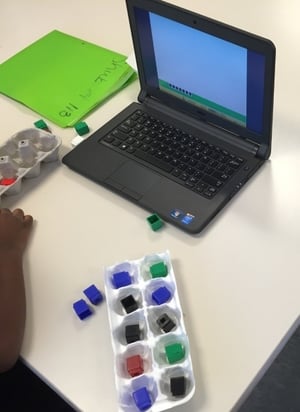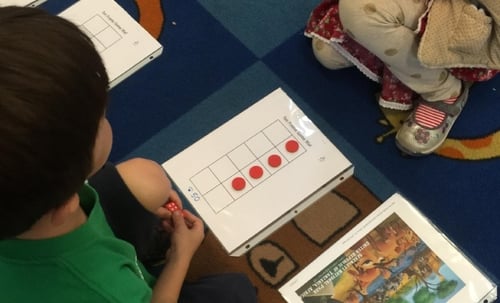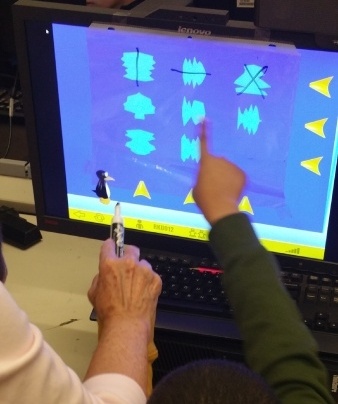
Manipulatives are objects that allow learners to interact with mathematical concepts. The learner changes the manipulative in some way, and the manipulative provides informative feedback. Research suggests that using maniuplatives (physical or virtual) has a positive effect on student achievement.
Check out how ST Math educators incorporate physical manipulatives with the education technology software to provide different ways to visualize and deeply explore math concepts, while promoting critical thinking and productive struggle.
Instead of keeping all manipulatives in one box, consider separating them into ready-to-go sets and packets for students to bring out as they need them. Students who can recognize when they need the support of physical manipulatives are taking ownership of their learning.
Using tools to help JiJi get where he needs to go! @JiJiMath pic.twitter.com/U0COxgBG0u
— Colleen Luce (@MissLuce1st) November 5, 2015
Different types of manipulatives will help students understand different concepts.
Cube manipulatives are versatile and easy to adapt for all types of education technology games, while some manipulatives, such as number lines and grids, will be most useful with specific content.
Allowing students to experiment with different manipulatives will help them develop the experience to determine which manipulatives will help them the most in different situations.
Love when they find manipulatives on their own to help solve math problems! @JiJiMath pic.twitter.com/fhk5MXfYZY
— Kasie Scally (@mrs_scally) January 4, 2016
These clever teachers use cardboard and styrofoam egg cartons to help contain manipulatives. You can cut off the last two egg portions to create ten frames where each section only fits one unit.
In addition to helping students develop a deeper understaning of tens, this can also help prevent small pieces from moving around and getting lost!

Bonus: egg cartons are easy to stack and store when not in use. Some places, such as chicken feed stores, may give away egg cartons for free or low-cost to local teachers for educational purposes.
Other creative containers include mini muffin tins, ice trays, fishing tackle boxes, bead boxes, muffin liners, empty watercolor tins, cookie trays and sheet protectors.
#STMATH @LeckieDC incorporate manipulatives when students are working independently @DCPSedTech @dcpublicschools pic.twitter.com/WhwNewIuWa
— Sakon Kieh (@OneTechChic) May 27, 2016

Ten frames mat created by Bobbi Frensley, from George C. Payne Elementary School in San Jose, CA
This teacher found clock manipulatives that go perfectly with the time puzzles in ST Math.
First and third grade students @Lancasterschool were happy to set goals and work hard in ST Math today. @JiJiMath @grade3smarties #growthmindset #progress #STEM pic.twitter.com/V7v8n2piYT
— STEM K-5 SAU57 (@K_5_STEM_SAU57) April 20, 2018
ST Math tip: check out the different printables on ST Math Central that allow students to physically keep track of their progress in the program. When students actively track their goals, they take ownership of their learning.
Using protective sheets and dry erase markers on screens allows students to try different approaches before submitting a solution to the program. This can help students break down multi-step problems and create theories about the feedback they will receive from the program.

Materials that can be used on screens include wikki stix, sticky hands, and dry erase markers, though you may also want to protect the screen with a clear protector sheet.
ST Math tip: Check out the list of game mats on ST Math Central that you can print for your class to use with the games in ST Math!
Using manipulatives to solve @JiJiMath problems! #kindergarten #finalcone pic.twitter.com/ZaYSvmLepC
— Brian Reynolds (@iReyn) March 17, 2016
Magnets on the whiteboard can act as manipulatives that are large enough to demonstrate to the entire classroom. Draw your grid, ten frames or chart onto the whiteboard or use a projector.
This teacher from Ohio projects a game from ST Math onto the whiteboard and uses large magnets to bring edtech into the classroom and physical space:
Learning WHAT happens when Ss multiply a whole number by a fraction that is less than 1. @JiJiMath @Twanayoung pic.twitter.com/pXSnxV0xxj
— Damicka Bates (@DamickaBates) June 14, 2016
This teacher from Florida cut up pool noodles (can be found at dollar stores or big box stores) as an affordable, big way to manipulate place value.
There’s nothing better than giant manipulatives! Ss work together to build 3 digit addition problems using place value and regrouping. 📚❤️@iLearnInc @JiJiMath #math #Students #studentsuccess pic.twitter.com/edXBNcMRAU
— StarrBoldt (@StarrBoldt1) April 13, 2018
Anecdotal evidence confirms the research; educators see great benefits in their student's critical thinking with using manipulatives. Not only when students are actively using the manipulatives, but also when students need to think about which manipulatives to use and how to recreate the problem. As the teacher above describes:
Building the problem then physically moving through the problem provides better understanding of the strategy.
Do your students have a particular game they love to replay or are they stuck on a particular level? A new perspective could help them try a new way of viewing or approaching the problem.
DIY model created collaboratively-first graders challenged by Kickbox @JiJiMath @CajonValleyUSD JiJi makes us think! pic.twitter.com/HtgTIYYiZE
— Michele Barbour (@megbarbour5) January 15, 2016
Thank you to all of the educators who shared how their students are using physical manipulatives with ST Math!
Do you have a clever use of math manipulatives to share? Tweet to us @JiJiMath!
Read more about what educators are saying about how ST Math facilitates deeper learning, or learn more below!

Calli Wright was the Marketing Manager at MIND Research Institute. She loves playing and designing board games, which she often talks about on twitter @CalliWrights.
Comment